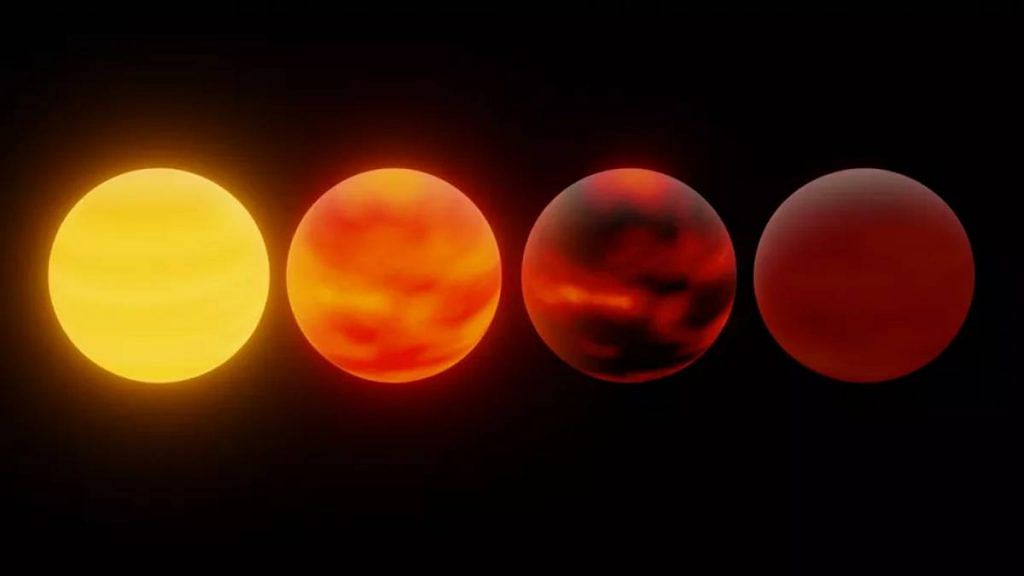New Delhi: Scientists at NASA have discovered why some planets form clouds of silicates, the family of rock-forming minerals that make up over 90 per cent of earth’s crust.
The team looked at observations by the now-retired Spitzer Space Telescope, and found a common trait among distant worlds where the exotic clouds form.
The research reveals the temperature range at which silicate clouds can form and are visible at the top of a distant planet’s atmosphere. The finding was derived from observations by Spitzer Space Telescope of brown dwarfs – celestial bodies that fall in between planets and stars – but it fits into a more general understanding of how planetary atmospheres work.
The steps to make any type of cloud are the same. First, heat the key ingredient until it becomes a vapour. Once it is cooled just enough for it to condense, clouds are formed.
Since rock vaporises at a much higher temperature than water, silicate clouds are visible only on hot worlds, such as the brown dwarfs used for this study and some planets outside our solar system.
Although they form like stars, brown dwarfs aren’t massive enough to kick-start fusion, the process that causes stars to shine. Many brown dwarfs have atmospheres almost indistinguishable from those of gas-dominated planets, such as Jupiter, so they can be used as a proxy for those planets.
A study based on the research was published in Monthly Notices of the Royal Astronomical Society in May. Read More.
Also read: Scientists say it’s theoretically possible to communicate with extraterrestrial beings
Why woodpeckers do not get concussions
Rather than acting like shock-absorbing helmets, woodpeckers’ heads act more like stiff hammers, according to scientists who have been studying how woodpeckers can repeatedly pound their beaks against tree trunks without doing damage to their brains.
Researchers from Universiteit Antwerpen in Belgium analysed high-speed videos of three species of woodpeckers, and found that woodpeckers do not absorb the shock of the impact with the tree.
The team concluded that the woodpeckers’ usual pecking on tree trunks is generally well below the threshold to cause a concussion, even without their skulls acting as protective helmets. This is because of the smaller size of their heads.
The findings, which were reported on July 14 in Current Biology, refute the long-held theory of shock absorption, which has been popularised in the media, books, zoos, and more.
From an evolutionary point of view, the findings may explain why there aren’t woodpeckers with much larger heads and neck muscles. While a larger woodpecker could deliver more powerful pecks, likely concussions would cause them major problems. Read More.
Mysterious ‘milky sea’ glow caught on camera for first time
In a first, researchers have captured on camera a phenomenon that makes the ocean turn milky white.
For centuries, mariners have described a mysterious milky glow in the oceans, but scientists never got a chance to study the phenomenon before.
Between late July and early September 2019, US National Oceanic and Atmospheric Administration satellites captured such a milky white glow south of Java, Indonesia, spanning more than 100,000 sqkm.
Moreover, sailors onboard a superyatch called Ganesha provided confirmation of the phenomenon as well as the first real-world images.
Researchers from Colorado State University in the US, working with the sailors, have published the event – plus 11 other possible instances of milky seas – in Nature Scientific Reports. Read More.
New species of fungi that thrive in cold mountains discovered in Scotland
Two species of rare fungi have been discovered in Scotland’s Cairngorms mountains – both of which thrive in cold habitats.
Volunteers working with James Hutton Institute and Plantlife – an international wild plant conservation charity – found the two species.
Amanita groenlandica is an arctic species originally described from Greenland and circumpolar in its distribution, with Scandinavia its previously recorded most southerly location. Acrodontium antarcticum is a fungus originally described from Antarctica.
Due to its elevation and distance from the sea, the Cairngorms region experiences an exceptionally cold and snowy climate.
Up to 219 soil samples were collected by the hillwalking community at various altitudes from 55 of the 58 munros (mountains more than 3,000 ft high) of Cairngorms National Park last summer, and DNA was extracted from the soil and sequenced by scientists at the institute, resulting in over 17,000 records of 2,748 fungal species in just three months. Read More.
166-million-year-old fossil represents oldest salamander species in Europe
Scientists have discovered the oldest salamander fossil in Europe – a 166-million-year-old animal called Marmorerpeton, found in Middle Jurassic rocks on the Isle of Skye.
Researchers from University College London who analysed the fossil found several key salamander traits, but the species is not part of the modern group of salamanders.
Marmorerpeton was first described 30 years ago, but only a few isolated fossil vertebrae and partial jawbones were found, making it somewhat enigmatic.
The new research, reported in Proceedings of the National Academy of Sciences, adds a wealth of new data, leading to the discovery of a new species – Marmorerpeton wakei.
The fossil is important because it preserves combinations of anatomical features that do not exist in any living animal, according to the researchers.
Salamanders, which include newts, are a type of amphibian. Unlike frogs, they have a tail and are more variable in size and shape. There are over 700 species found across the northern hemisphere in various freshwater and woodland habitats. They are renowned for their ability to regrow limbs and organs. Read More.
(Edited by Nida Fatima Siddiqui)
Also read: ‘Fluffy’ crab from Australia that wears sea sponge like a hat named after Darwin’s ship
